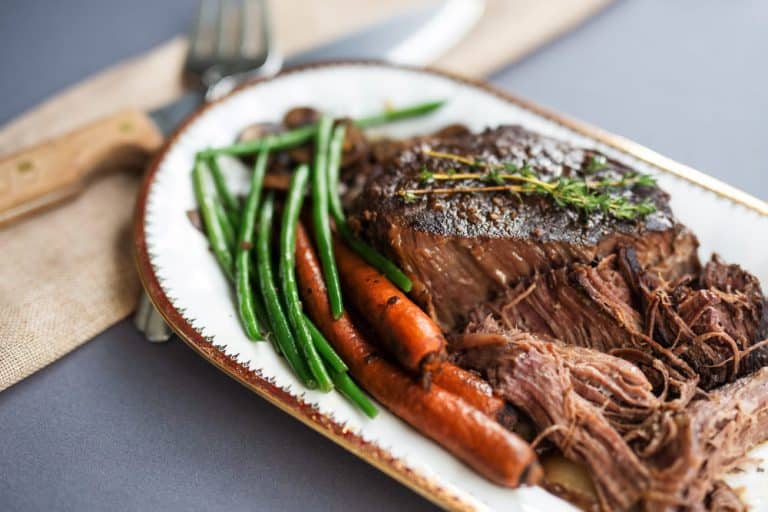I bought a 3 1/2 lb bottom round for pot roast. I seared all sides then put it in a stainless steel heavy pot with carrots, celery, onion and aromatics plus I added water about half way and cooked very gently on low for 3 hours and its still not done!!! That was last night.
This morning I took it out of the frig and slowly brought it back to a simmer for another 2 hours and its still tough. HELP
Hi, Arlene. So good to hear from you! So sorry, though, that your pot roast stayed tough. There are several reasons why this could have happened even after so much cooking. First, your choice of a rump roast could be a factor since cuts from the hind quarter are very muscular and, since muscles are the most resistant to breaking, this cut is quite stubborn when it comes to becoming tender. Muscular cuts are also leaner than those less used by the animal and have less connective tissue which is what’s prized in meats to be slow-braised. Connective tissue (which starts out as sinew, gristle, tendons and ligaments) are most abundant in cuts like brisket and chuck (not rump) and it’s the connective tissue that, when it reaches a temp. of 150F just begins to dissolve into gelatin and it’s THIS that helps to create the succulence you’re after. At that point, with continued very gentle “wet” cooking (and with a lid that is very secure) the meat will be on its way to becoming tender (160F is when succulence really starts to happen). Rump will work, eventually, if the meat itself was from a “good specimen.” Often, although a carcass is labeled “choice” or even “prime” by the USDA, this is not always indicative of a particular slab of meat since often the animal is judged in it’s entirety without having it’s individual parts inspected for quality.
Then there’s the slicing… which MUST be done against the grain across the lines of connection within the meat) or your slices will literally fall apart into a stringy mess! When it’s rump, you need to slice the meat very thin in order to not feel the “chew.”
What I always do when making a brisket (which I suggest you do with your rump roast) is to, after it’s initial cooking, let the meat cool to just warm in the sauce, then slice and lay the slices in a baking dish surrounded by the sauce. Then reheat this at 350F until piping hot which will give the individual slices more direct exposure to wet heat. This should help.
So, my suggestion is to, next time, purchase a brisket or chuck roast (for it’s abundance of connective tissue). After cooking, allow the meat plenty of resting time in the hot sauce since this will also allow the meat to continue cooking as it settles down. Slice the meat thin (you can slice brisket thicker, which I personally like) and reheat the slices in the sauce (which actually becomes a timing bonus since you can cook the meat a day or two ahead, leave it sliced in the sauce in the fridge and then bring it close to room temp and reheat fully.

Every pot roast Ive attempted to make had amazing broth and vegetables but the meat was tough and chewy I dont know what the heck Im doing wrong Ive cooked it 5 hours 6 hours 8 hours. What am I doing wrong?
What I always do when making a brisket (which I suggest you do with your rump roast) is to, after it’s initial cooking, let the meat cool to just warm in the sauce, then slice and lay the slices in a baking dish surrounded by the sauce. Then reheat this at 350F until piping hot which will give the individual slices more direct exposure to wet heat. This should help.
I bought a 3 1/2 lb bottom round for pot roast. I seared all sides then put it in a stainless steel heavy pot with carrots, celery, onion and aromatics plus I added water about half way and cooked very gently on low for 3 hours and its still not done!!! That was last night.
Then there’s the slicing… which MUST be done against the grain across the lines of connection within the meat) or your slices will literally fall apart into a stringy mess! When it’s rump, you need to slice the meat very thin in order to not feel the “chew.”
This morning I took it out of the frig and slowly brought it back to a simmer for another 2 hours and its still tough. HELP
So, my suggestion is to, next time, purchase a brisket or chuck roast (for it’s abundance of connective tissue). After cooking, allow the meat plenty of resting time in the hot sauce since this will also allow the meat to continue cooking as it settles down. Slice the meat thin (you can slice brisket thicker, which I personally like) and reheat the slices in the sauce (which actually becomes a timing bonus since you can cook the meat a day or two ahead, leave it sliced in the sauce in the fridge and then bring it close to room temp and reheat fully.
How To Turn Tough Meat Into Tender Perfection
FAQ
Why is my pot roast not getting tender?
How do you soften a tough pot roast?
Does pot roast get more tender the longer it cooks?
What to do with a tough pot roast?
